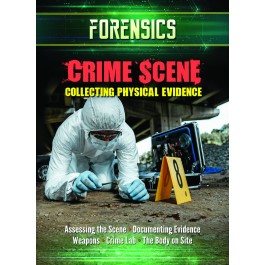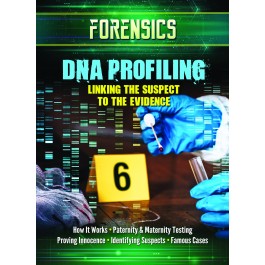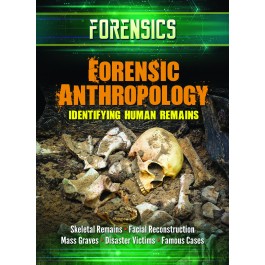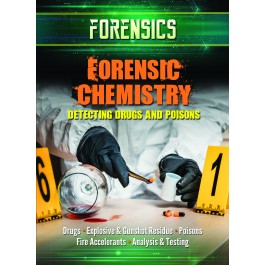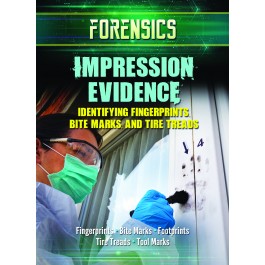FORENSICS

0
2022
12+
7th - 12th
6.5 x 9
by Jennifer Rowan
| eBook | ISBN 978-1-4222-7340-1 | $32.95 | Add To Cart |
A crime is committed, and police are called. But what happens next? This book looks at how forensics is used to solve violent crimes by explaining how police assess a crime scene and collect and analyze evidence, as well as exploring the roles of various crime scene investigators and analysts. Real-life murder cases are presented throughout as examples of how investigators have solved crimes in the past. Readers will learn about DNA testing, fingerprinting methods, and other proven techniques for solving crimes. They will also be introduced to key personnel involved in criminal investigations, from the crime scene investigators who first arrive on the scene to the medical examiners and lab technicians who piece together solutions and will discover more about the relationship between law enforcement and science. Read on and start
sleuthing!
by Amy Sterling Casil
| eBook | ISBN 978-1-4222-7341-8 | $32.95 | Add To Cart |
Digital forensics, also known as “computer forensics,” is one of the fastest-growing professional fields in the world. Experts who can protect the computer systems and mobile devices of companies, individuals, and government organizations are in high demand. Digital forensics experts can, and do, solve crimes using digital evidence they find on cell phones, computers, and on the Internet. From stopping the theft of personal information to protecting children from Internet predators, digital forensics experts work to safeguard the public and prevent crime. Machine learning and artificial intelligence are already contributing to cyber safety and offer more crime-prevention potential in the future, from real-life robocops to facial recognition technology that might allow you to buy groceries with a glance to verify who you
are.
by Amy Sterling Casil
| eBook | ISBN 978-1-4222-7342-5 | $32.95 | Add To Cart |
From the field of genomics, which can help identify rare illnesses or develop medicines to treat cancer and Alzheimer’s disease, to ancestry databases that can reveal genetic heritage and family relationships, DNA research can uncover hidden truths. DNA analysis can determine a baby’s father, track down a hard-to-find criminal suspect, and even find out which neighbor isn’t cleaning up after their dog. From its origins in the 1980s, DNA profiling has led to the capture and conviction of thousands of criminals. Misunderstanding of DNA technology has also led to the wrongful convictions of a number of people for crimes they didn’t commit. Whether it is being used to identify a killer, reconstruct the face of an unknown victim, or prove that someone is innocent, DNA profiling is a fascinating field using ever-evolving
technology.
by Amy Sterling Casil
| eBook | ISBN 978-1-4222-7343-2 | $32.95 | Add To Cart |
Forensic anthropologists sometimes call themselves “speakers for the dead.” They study human remains to help solve crimes, identify missing persons, and discover the identity of unidentified remains. Forensic anthropologists can work with law enforcement and other government agencies. They can also travel around the world to recover and analyze remains. They can work as part of archaeological teams to discover what happened at the site of an ancient battle, help to confirm the identity of a famous person from historical times, or help to identify people who have lost their lives in a plane crash or other disaster. Forensic anthropology began in the early 20th century and continues to evolve today, using DNA analysis and data to reveal the appearance, the identity, and potentially the cause of death of human
remains.
by Katherine Lacaze
| eBook | ISBN 978-1-4222-7344-9 | $32.95 | Add To Cart |
When examining a crime scene, investigators rarely discover a smoking gun—figuratively or literally. Rather, they are more likely to find gunshot residue, an aging bloodstain, a piece of fiber, a suspicious white powder, or some unknown chemical substance that requires thorough testing and analysis to prove useful to the criminal justice process. That’s where forensic chemists come in. On any given day, a forensic chemist may be asked to examine human tissue to look for poison or drugs, analyze charred wood from a fire scene to uncover fire accelerants, or test rubble from the site of an explosion to determine what volatile agents were used. With their specialized knowledge and skillset, forensic chemists can apply a variety of scientific techniques and instruments to identify unknown substances found at crime scenes and extract other data, which turns the microscopic remnant into a valuable clue for understanding what happened when, where, and by whom. This circumstantial
evidence, and the forensic chemist’s expert interpretation of it, are critical not only to investigating crimes and tracking down potential suspects but also to rigorously prosecuting offenses and providing juries and judges with objective information they can use to make informed decisions when carrying out justice.
by Katherine Lacaze
| eBook | ISBN 978-1-4222-7345-6 | $32.95 | Add To Cart |
The term forensic psychology may conjure intriguing images of brilliant criminal profilers who track down dangerous serial killers based on psychological clues left behind at crime scenes or dug up from a suspect’s past. While that is one part of forensic psychology, the field is broader and more diverse, making it a critical component of the modern criminal justice system. Forensic psychologists assume a number of responsibilities throughout each stage of the law enforcement process, assisting in investigations, informing verdicts, and influencing sentencing. On any given day, they may help narrow down suspects, interview witnesses, evaluate the mental competency of defendants, assess motives and behaviors, and provide expert testimony in both civil and criminal cases. While the work of forensic psychologists is not always as intense or exciting as films and television portray it to be, it is undoubtedly interesting, challenging, and rewarding. Since it became a recognized specialty
in 2001, forensic psychology has continued to evolve as a practice, attracting bright professionals who are fascinated by the intersection of human behavior and the legal system and firmly believe it can make a difference in improving society.
by Katherine Lacaze
| eBook | ISBN 978-1-4222-7346-3 | $32.95 | Add To Cart |
When criminals commit crimes, they interact with the environment in a way that leaves behind traces of their behavior, movement, and even identity. They may flee from the scene of a crime in a vehicle that produces an impression of their tire tread in the mud, or they may leave behind a fingerprint on the sill of the window they used to gain access to a victim’s home. Any time two objects come into contact with a certain amount of force, the result is an impression—sometimes visible to the naked eye, sometimes not. Impression evidence that is frequently found at crime scenes includes toolmarks, shoeprints, and tire tread marks, in addition to fingerprints and bite marks. Forensic scientists who specialize is a specific category of impression evidence are critical to its effective use in the world of criminal justice. They search crime scenes, and upon finding impression evidence, carefully document, record, and preserve it. They can also apply their extensive knowledge and training
to interpret the evidence, figure out how it fits into the bigger picture, and determine whether it contains any data that can answer the who, what, when, where, why, and how of the crime.
by Amy Sterling Casil
| eBook | ISBN 978-1-4222-7347-0 | $32.95 | Add To Cart |
Forensic pathologists are also called “medical examiners.” They are physicians with years of training whose job it is to discover how people died in sudden or suspicious circumstances. They are a vital part of criminal investigations. Without forensic pathologists, many murders would never be solved. The work of forensic pathologists involves more than just crime solving and court testimony. Forensic pathologists also provide closure to families who want to know how their loved ones died. Their work is fascinating, but it can be disturbing and challenging. Forensic pathology isn’t for the faint of heart or weak of stomach, but it is a rewarding career for doctors who love to solve problems. Using techniques that date back hundreds of years as well as cutting-edge technology, forensic pathologists uncover the secrets of life and death. Read on to learn more about this unique branch of the medical
sciences.











